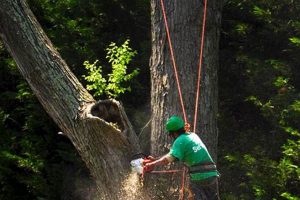Creating miniature trees at home involves the art of replicating full-sized trees in small containers. This undertaking requires shaping and cultivating a plant, often a young tree or shrub, through techniques like pruning, wiring, and root trimming to mimic the aesthetic of a mature tree in a compact form. The practice transforms ordinary plant material into a unique display, showcasing horticultural skill and artistic vision.
The benefits of engaging in this pursuit extend beyond aesthetics. It provides a therapeutic activity, fostering patience and mindfulness through the regular care and maintenance required. Furthermore, the process connects individuals with nature in an intimate and rewarding way, offering a personalized expression of horticultural art. Historically, the development of these miniature landscapes reflects a deep appreciation for nature and a desire to capture its essence in a manageable scale, originating from ancient practices of container gardening.
The subsequent sections will delve into the selection of suitable plant species, the essential tools required, and the fundamental techniques involved in shaping and maintaining these miniature arboreal representations. Further considerations include soil composition, watering schedules, and pest management strategies critical for long-term health and vigor.
Tips for Aspiring Miniature Tree Cultivators
Successfully cultivating miniature trees demands meticulous attention to detail and a commitment to ongoing learning. The following tips offer guidance for achieving optimal results in the art of creating miniature trees at home.
Tip 1: Species Selection: Opt for plant species known for their resilience, adaptability to container environments, and ability to withstand pruning. Ficus, junipers, and maples are frequently recommended due to their compact growth habits and visual appeal.
Tip 2: Proper Soil Composition: Utilize a well-draining soil mix designed specifically for these miniature trees. This typically consists of a blend of akadama, pumice, and lava rock to ensure adequate aeration and drainage, preventing root rot.
Tip 3: Strategic Pruning Techniques: Employ pruning techniques to shape the plant and maintain its desired size. Regular trimming of new growth and selective removal of branches contribute to a balanced and aesthetically pleasing form.
Tip 4: Wiring for Branch Positioning: Use specialized wiring to gently guide branches into desired positions. Apply the wire carefully to avoid damaging the bark, and monitor the plant closely to prevent the wire from cutting into the growing branches.
Tip 5: Consistent Watering Practices: Maintain consistent moisture levels in the soil, avoiding both overwatering and underwatering. Adjust the watering frequency based on the species, climate, and soil composition.
Tip 6: Regular Fertilization: Provide balanced fertilization during the growing season to support healthy growth. Use a diluted liquid fertilizer specifically formulated for these miniature trees, following the manufacturer’s instructions.
Tip 7: Pest and Disease Management: Regularly inspect the plant for signs of pests or diseases. Implement appropriate control measures, such as insecticidal soap or horticultural oil, to prevent infestations and maintain plant health.
Mastering these techniques yields a fulfilling connection with nature while developing a distinctive aesthetic expression. Diligence, observation, and consistent practice are the cornerstones of success.
The final section summarizes essential considerations for long-term success in cultivating these miniature arboreal creations.
1. Species Suitability
Species suitability is a foundational element in the successful creation of miniature trees at home. Selecting an appropriate species directly impacts the ease of cultivation, aesthetic possibilities, and the plant’s overall health and longevity. The following considerations detail critical facets of species selection in this context.
- Growth Habit and Form
Certain tree species naturally exhibit growth habits that lend themselves well to miniaturization. Species with smaller leaves, shorter internodes, and a tendency to develop intricate branching patterns are inherently easier to shape into aesthetically pleasing representations. Examples include Japanese maples (Acer palmatum), which possess naturally small leaves and elegant branching, and dwarf junipers (Juniperus procumbens ‘Nana’), which exhibit a compact, spreading form. Selecting species with these inherent characteristics minimizes the need for drastic shaping and reduces stress on the plant.
- Adaptability to Container Culture
Not all tree species thrive in the confined environment of a container. Species selected for miniature tree cultivation must be able to tolerate restricted root growth, limited nutrient availability, and potentially inconsistent watering schedules. Ficus species, such as Ficus retusa, are highly adaptable to container environments and exhibit vigorous root growth even in small pots. Conversely, species with deep taproots or high moisture requirements may struggle to adapt and are generally unsuitable for miniature tree cultivation.
- Tolerance to Pruning and Shaping
The art of miniature tree creation relies heavily on pruning and shaping techniques to achieve the desired aesthetic. Therefore, selecting species that readily tolerate pruning and wiring is crucial. Species like Japanese black pine (Pinus thunbergii) respond well to pruning and can be manipulated to create dramatic, windswept forms. Conversely, species that exhibit poor wound healing or sensitivity to branch removal are less amenable to shaping and may be prone to disease or decline.
- Climate Hardiness
Consideration of climate hardiness is essential to ensure the long-term survival of the cultivated miniature tree. Selecting a species that is well-suited to the local climate minimizes the risk of damage from extreme temperatures, frost, or excessive sunlight. For example, a species that thrives in a temperate climate may not survive in a region with harsh winters or scorching summers. Matching the species to the local climate reduces the need for extensive environmental control and ensures the plant’s continued health and vigor.
Ultimately, the careful consideration of species suitability is a prerequisite for successfully creating and maintaining miniature trees. Selecting species that possess favorable growth habits, adaptability to container culture, tolerance to pruning, and climate hardiness increases the likelihood of achieving a visually appealing and long-lived miniature representation of a full-sized tree. Choosing wisely simplifies the process and improves the probability of cultivating a satisfying arboreal miniature.
2. Pruning Techniques
Pruning techniques are integral to the creation and maintenance of miniature trees at home. These methods, involving the selective removal of plant parts, are essential for shaping the tree, controlling its size, and promoting its overall health and aesthetic appeal.
- Structural Pruning
Structural pruning establishes the foundational framework of the miniature tree. It involves the removal of branches that detract from the desired form, such as those that are crossing, growing inward, or are excessively thick. For example, removing a dominant vertical branch redirects energy to lateral branches, fostering a more balanced and compact structure. This technique is crucial in dictating the tree’s overall silhouette and visual impact.
- Maintenance Pruning
Maintenance pruning focuses on the removal of dead, diseased, or damaged branches to promote plant health and prevent the spread of infection. Regularly removing yellowing leaves or branches affected by fungal diseases ensures the plant’s vitality. This proactive approach maintains the tree’s aesthetic appeal and contributes to its long-term survival.
- Foliage Pruning
Foliage pruning involves the selective removal or trimming of leaves and needles to control density and improve light penetration. Defoliation, the complete removal of leaves, can be employed to stimulate new growth and reduce leaf size. Reducing leaf density allows for better air circulation, reducing the risk of fungal diseases. This technique is critical for refining the overall appearance of the miniature tree and promoting a refined aesthetic.
- Root Pruning
Root pruning is performed during repotting to control root growth and prevent the tree from becoming root-bound. Removing a portion of the root mass stimulates new root growth and ensures the plant’s continued health in the confines of its container. This is vital for maintaining the balance between the above-ground growth and the root system, contributing to the overall vigor and longevity of the tree.
These pruning techniques, when applied with precision and understanding, are essential components of the miniature tree cultivation process. They enable the creation of aesthetically pleasing miniature representations of full-sized trees while ensuring the plant’s long-term health and vitality. Mastering these skills is crucial for any individual embarking on the journey of creating these miniature trees at home.
3. Wiring application
Wiring application is a pivotal technique in the process of creating miniature trees at home. It involves the careful manipulation of branches using specialized wire to guide their growth and achieve a desired aesthetic form. The connection between wiring and the creation of miniature trees is one of cause and effect: the skillful application of wire results in controlled branch positioning, shaping the overall appearance of the tree. Without this technique, the tree’s natural growth patterns may not align with the desired aesthetic, hindering the goal of replicating a mature tree in miniature. An example of this is the creation of a cascading style, where branches are wired downwards to simulate the effect of age and gravity.
The practical significance of understanding wiring application lies in its ability to enhance the artistic expression of the creator. By mastering this technique, individuals can influence the direction and density of branching, correct undesirable growth patterns, and create visually compelling miniature landscapes. For instance, wiring can be used to open up the interior of the tree, allowing more light and air to penetrate, promoting healthier growth. Moreover, precise wiring techniques prevent branches from growing straight up, which is a common characteristic of young trees and detracts from the appearance of age and maturity in the miniature form. The correct choice of wire gauge and material, along with careful application to avoid bark damage, are critical elements of successful wiring.
In summary, wiring serves as a crucial component for the formation and maintenance of miniature trees. It empowers the practitioner to control the form and style of the tree, resulting in a unique and aesthetically pleasing miniature representation. Challenges can arise from improper wiring techniques, such as girdling branches or causing scarring. However, with careful planning, appropriate materials, and diligent practice, wiring application can significantly enhance the final result, and contribute to the successful creation of miniature trees at home. This technique, therefore, represents a vital link in the chain of processes involved in the art of creating miniature trees at home.
4. Soil composition
Soil composition is a determinant of successful miniature tree cultivation. It directly influences root health, nutrient uptake, and overall plant vitality. A proper soil mixture for miniature trees is not merely dirt; it is a carefully formulated blend designed to mimic the drainage and aeration characteristics found in the natural environments of full-sized trees. The soil must facilitate efficient water passage to prevent root rot while retaining sufficient moisture to sustain the plant. For example, using garden soil, which compacts easily and retains excessive moisture, frequently leads to root suffocation and eventual plant death. This illustrates a clear cause-and-effect relationship between soil composition and plant health in the constricted environment of a container.
The importance of understanding soil composition stems from its direct impact on nutrient availability. Miniature trees, confined within pots, rely entirely on the soil for essential nutrients. A well-composed soil blend allows for effective fertilization and prevents the buildup of harmful salts. For instance, a mixture of akadama, pumice, and lava rock provides excellent drainage and aeration while also allowing for the gradual release of nutrients from slow-release fertilizers. This combination addresses the plant’s specific needs in a way that ordinary soil cannot. Furthermore, the components of the soil contribute to its structure and stability, preventing the roots from being disturbed during watering or handling.
In summary, soil composition is a critical factor in the creation and maintenance of these miniature trees. The careful selection and blending of soil components contributes to optimal root health, nutrient availability, and overall plant vigor. Ignoring these principles often results in plant decline and failure. A detailed comprehension of soil composition’s impact on root development and plant health translates directly into a more successful and rewarding horticultural pursuit.
5. Watering regimen
Establishing a precise watering regimen is paramount to the health and longevity of the homemade miniature tree. The delicate balance between hydration and aeration within the confined root system necessitates careful consideration of various factors.
- Frequency and Timing
Watering frequency should be dictated by environmental conditions, soil composition, and species-specific needs. Overwatering, a common pitfall, leads to root rot, whereas underwatering causes desiccation and stunted growth. Visual inspection of the soil surface and tactile assessment of the soil’s moisture level provide valuable indicators. Morning watering allows foliage to dry before nightfall, minimizing fungal disease risk. For example, a juniper in well-draining soil in a hot, dry climate may require daily watering, while a ficus in a more humid environment may only need watering every few days.
- Water Quality
The quality of water used significantly impacts the health of these miniature trees. Tap water often contains chlorine and other chemicals that can accumulate in the soil and harm beneficial microorganisms. Rainwater or dechlorinated water are preferable options. Hard water, containing high mineral content, can also lead to mineral buildup in the soil, affecting nutrient uptake. Filtration or the use of distilled water mitigates these potential issues.
- Watering Technique
The manner in which water is applied is as important as the water itself. Slow, deliberate watering ensures that the entire root ball is thoroughly saturated. Avoid forceful spraying that can erode the soil or damage delicate foliage. Submersion watering, where the pot is immersed in water until the soil surface is moist, is an effective method for rehydrating dry soil. Consistent, even watering promotes uniform growth and prevents localized dry spots.
- Seasonal Adjustments
Watering needs fluctuate with the changing seasons. During the active growing season, miniature trees require more frequent watering to support new growth. In contrast, during the dormant season, watering should be reduced to prevent root rot. Temperature, humidity, and sunlight intensity all influence water evaporation rates, necessitating adjustments to the watering schedule. Consistent monitoring and adaptation are key to maintaining optimal moisture levels throughout the year.
Integrating these elements into a consistent and adaptable watering regimen is essential for success in the creation of homemade miniature trees. A nuanced approach, tailored to the specific needs of the plant and its environment, facilitates long-term health and aesthetic refinement.
DIY Bonsai Tree FAQs
The following addresses common questions and concerns regarding the creation and maintenance of miniature trees at home, offering clarity and guidance for enthusiasts.
Question 1: What tree species are most suitable for amateur miniature tree cultivation?
Certain species exhibit characteristics that make them more amenable to the constraints of container gardening and the techniques of pruning and shaping. Recommended species include Ficus (various varieties), junipers (particularly Juniperus procumbens), and Japanese maples (Acer palmatum). These species demonstrate resilience, adaptability, and aesthetic appeal, making them favorable choices for beginners.
Question 2: What is the importance of specialized soil for a miniature tree?
Specialized soil mixtures, typically composed of components such as akadama, pumice, and lava rock, provide optimal drainage and aeration. Standard potting soil tends to retain excessive moisture, leading to root rot, a common cause of plant demise in container gardening. The unique composition of specialized mixtures facilitates healthy root development and nutrient uptake.
Question 3: How frequently should miniature trees be watered?
Watering frequency depends on several factors, including the species, soil composition, climate, and container size. Overwatering is more detrimental than underwatering. The soil should be allowed to dry slightly between waterings. A visual assessment of the soil surface and a tactile check of the soil’s moisture level are reliable indicators. As a general guideline, water thoroughly when the top inch of soil feels dry to the touch.
Question 4: What are the essential tools for cultivating miniature trees?
A basic toolkit includes concave cutters for branch removal, wire cutters for shaping branches, root hooks for untangling roots during repotting, and tweezers for removing debris. Specialized watering cans with fine nozzles prevent soil erosion. These tools facilitate precise manipulation and promote plant health.
Question 5: Is wiring necessary for shaping miniature trees?
Wiring is a valuable technique for guiding branch growth and achieving the desired aesthetic form. However, it requires careful application to avoid damaging the bark. Monitor the wire regularly to prevent it from cutting into the branches as they grow. Alternative techniques, such as pruning and positioning, can also contribute to shaping, although wiring often provides more immediate and dramatic results.
Question 6: How often should a miniature tree be repotted?
Repotting frequency depends on the age and growth rate of the tree. Younger, faster-growing trees typically require repotting every one to two years, while older, more established trees may only need repotting every three to five years. Repotting allows for root pruning, replenishes the soil, and prevents the tree from becoming root-bound.
Mastering the art of miniature tree creation requires ongoing learning, patience, and attention to detail. Understanding these fundamental principles will contribute to the successful cultivation and appreciation of these miniature arboreal representations.
The following section summarizes key considerations for long-term success in cultivating and maintaining miniature trees at home.
diy bonsai tree
This exploration of diy bonsai tree has covered the fundamental techniques and considerations necessary for successful cultivation. Key aspects include species selection, appropriate soil composition, meticulous pruning, skillful wiring, and a consistent watering regimen. Mastering these elements is essential for achieving both aesthetic appeal and the long-term health of the miniature tree.
The sustained practice of creating miniature trees at home demands commitment and patience. The principles outlined serve as a foundation for ongoing learning and refinement. Continued diligence in observation and application will yield increasingly rewarding results, transforming ordinary plant material into enduring works of horticultural art.







